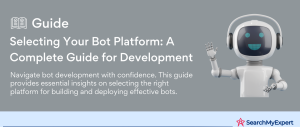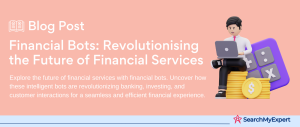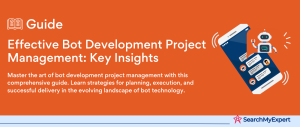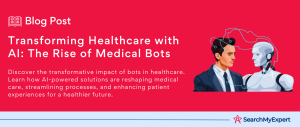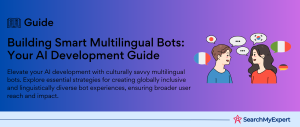Bot Development Tools and Frameworks
Understanding the Rise of Bot Development Tools and Frameworks
In today’s digital era, bots have become an integral part of various industries, revolutionizing the way we interact with technology. These intelligent programs, designed to automate tasks and simulate human interaction, are not just a glimpse into the future; they’re a vital component of the present tech landscape. With their growing significance, the need for efficient and robust bot development tools and frameworks has never been more crucial.
The Need for Advanced Bot Development Tools
Bots are no longer a novelty but a necessity, driving advancements in customer service, e-commerce, healthcare, and many other sectors. As their applications expand, so does the complexity of their development. This necessitates tools and frameworks that not only streamline the creation process but also ensure bots are smart, responsive, and secure.
Outlining the Bot Development Toolkit
Our exploration into bot development tools and frameworks will be comprehensive and multi-faceted. We will delve into the different categories of tools available, each designed to cater to specific aspects of bot development. From designing conversational flows to integrating AI capabilities, these tools form the backbone of successful bot creation. Let’s take a closer look at each category:
- Conversational Interfaces and Design Tools:
These tools focus on the user experience, ensuring that the bot can conduct natural and engaging conversations. - NLP and AI Integration Frameworks:
Vital for making bots intelligent, these frameworks enable bots to understand and process human language, learn from interactions, and make decisions. - Testing and Deployment Platforms: Essential for the lifecycle of bot development, these platforms ensure that bots function as intended and are ready for deployment in various environments.
- Analytics and Optimization Tools:
These tools provide insights into bot performance, user interaction patterns, and areas for improvement. - Security and Compliance Solutions:
With increasing concerns about data privacy and security, these tools ensure that bots adhere to legal standards and protect user data.
Understanding Bot Development Needs
Key Components of Bot Development
Developing a bot involves understanding and integrating various components that work together to create a seamless user experience. These key components include:
- Natural Language Processing (NLP):
NLP is at the heart of bot development. It enables bots to understand, interpret, and respond to human language in a way that feels natural and intuitive. Tools specializing in NLP are crucial for creating bots that can engage in meaningful conversations. - Dialogue Management: This component manages the flow of the conversation. It ensures that the bot can handle different conversation paths, maintain context, and provide coherent responses.
- Integration with Various Platforms: Bots need to be versatile, functioning across various messaging platforms, websites, and applications. Integration tools are essential for ensuring that bots can operate seamlessly on different channels.
- Machine Learning and AI Capabilities: Advanced bots require machine learning and AI to learn from interactions, adapt to user preferences, and provide personalized experiences.
- Analytics and Feedback Loops:
Monitoring bot performance and user interactions is vital. Analytics tools help in understanding user behavior, identifying issues, and improving both functionalities.
Types of Bots and Their Specific Needs
Bots come in various forms, each serving different purposes and thus, having specific development needs:
- Conversational Bots:
These bots simulate human conversation and are used in customer service, personal assistants, etc. They require robust NLP capabilities and sophisticated dialogue management to handle varied interactions. - Task-Oriented Bots:
Focused on performing specific tasks like booking tickets or setting reminders. These bots need efficient integration with relevant systems and a clear understanding of the task flow. - Informational Bots:
Designed to provide information like news updates, weather forecasts, etc. They need to be integrated with up-to-date data sources and have concise dialogue management. - Transactional Bots: Used for transactions like shopping or banking. They require high-security standards, integration with payment gateways, and a smooth user interface.
Choosing the Right Tools and Frameworks
Selecting the appropriate tools and frameworks is critical for the success of a bot development project. Factors to consider include:
- Project Requirements:
Understand the bot’s purpose and functionalities. A conversational bot for customer service will have different requirements compared to a task-oriented bot. - Platform Compatibility:
Ensure the tools support the platforms where the bot will be deployed, whether it’s a website, mobile app, or social media. - Scalability and Flexibility: Choose tools that can scale with increasing users and can adapt to changing requirements.
- User Experience: The tools should facilitate the creation of a bot that provides an engaging and intuitive user experience.
- Security and Compliance:
Particularly important for transactional and data-driven bots, the tools should ensure data protection and adhere to privacy regulations.
Exploring Popular Bot Development Tools
A Comparative Overview of Leading Bot Development Tools
The landscape of bot development tools is diverse, with each offering unique features and capabilities. Here, we’ll explore some of the most popular tools like Dialogflow, Rasa, Microsoft Bot Framework, and IBM Watson Assistant, comparing their strengths, weaknesses, and suitability for different types of bots.
Dialogflow (by Google)
- Strengths:
Known for its robust NLP capabilities, Dialogflow excels in creating conversational experiences. It integrates seamlessly with Google’s services and supports multiple languages, making it ideal for global applications. - Weaknesses:
While powerful, it can be complex for beginners and may require advanced coding skills for intricate customizations. - Functionality:
Offers easy integration with popular platforms like Facebook Messenger, Slack, and more. - Example:
A notable bot developed with Dialogflow is the KLM Royal Dutch Airlines bot, which provides flight information and customer service.
Rasa
- Strengths:
Rasa stands out for its open-source nature, allowing full customization. It’s particularly effective for creating sophisticated, context-aware bots. - Weaknesses:
Its open-source model means a steeper learning curve and potentially more development time. - Functionality: Offers advanced dialogue management and integrates well with existing systems.
- Example:
A successful application of Rasa is the financial advice bot ‘Sara’, which offers personalized financial guidance.
Microsoft Bot Framework
- Strengths: This framework is well-integrated with Microsoft’s ecosystem, including Azure services, and supports the development of bots across multiple channels.
- Weaknesses: Some developers find its integration with non-Microsoft services less straightforward.
- Functionality: Strong in multi-channel deployment and offers a range of cognitive services.
- Example:
‘Zo’, a social AI chatbot developed using this framework, showcases its conversational capabilities.
IBM Watson Assistant
- Strengths:
Known for its enterprise-grade solutions, Watson Assistant excels in creating highly intelligent and complex bots with strong learning capabilities. - Weaknesses: Can be costly for small-scale applications and requires a certain level of technical expertise.
- Functionality: Strong in enterprise integrations and data handling.
- Example:
Autodesk’s ‘Ava’, an AI assistant, provides efficient customer support, illustrating Watson’s robust AI capabilities.
Evaluating Tools for Bot Development
When evaluating these tools, consider:
- Ease of Use: For beginners, tools like Dialogflow might be more accessible compared to the more customizable but complex Rasa.
- Functionalities: Depending on the bot’s purpose, choose a tool that offers the necessary functionalities. For instance, Watson Assistant is ideal for complex, AI-driven bots.
- NLP Capabilities:
Tools like Dialogflow and Watson Assistant are leaders in NLP, suitable for creating highly conversational bots. - Platform Integrations: Consider the platforms where the bot will be deployed. Microsoft Bot Framework is excellent for integration across various Microsoft products.
Delving into Bot Development Frameworks
Advantages of Bot Development Frameworks
Bot development frameworks offer a comprehensive environment for building and managing bots. These frameworks provide several advantages over using individual tools:
- Modularity: Frameworks allow developers to build bots using modular components, making the development process more organized and manageable.
- Scalability:
They are designed to handle increasing loads, making it easier to scale bots as user demand grows. - Code Reusability:
Frameworks enable developers to reuse code across multiple projects, saving time and effort in the development process.
Key Bot Development Frameworks and Their Features
Rasa NLU & Core
- Key Features: Rasa combines Natural Language Understanding (NLU) and a dialogue management core. It excels in understanding user intent and managing complex conversation flows.
- Functionality:
Offers robust intent recognition and entity extraction, customizable to fit specific use cases. Its machine-learning capabilities allow for continuous improvement based on user interactions.
Wit.ai
- Key Features: Owned by Facebook, Wit.ai is known for its ease of use in creating voice and text-based bots. It specializes in turning natural language into structured data.
- Functionality: Provides effective intent recognition and entity extraction, and can integrate easily with Facebook Messenger and other platforms.
Botkit
- Key Features: Botkit is part of the Microsoft Bot Framework and offers a toolkit for developing bots on platforms like Slack, Facebook Messenger, and Twilio.
- Functionality: It includes a range of pre-built components for common bot functionalities and offers an interactive bot-building environment.
Exploring Framework Functionalities in Depth
Each of these frameworks provides unique capabilities:
- Intent Recognition:
Essential for understanding user requests. Rasa and Wit.ai are particularly strong in accurately identifying user intents from natural language inputs. - Entity Extraction:
This feature helps in pulling specific information from user inputs, like dates, locations, or names. Wit.ai excels in this area. - Dialogue Management Libraries: These are critical for maintaining the flow of conversation. Rasa Core, with its advanced dialogue management, ensures coherent and contextually relevant conversations.
Evaluating and Choosing the Right Tools & Frameworks
Creating a Decision-Making Framework for Bot Tools & Frameworks
Selecting the right tools and frameworks for bot development is a critical decision that can impact the project’s success. Here’s a decision-making framework to guide this process:
- Assess Project Requirements: Begin by understanding the bot’s intended functionality. Is it a simple FAQ bot, or does it require complex interactions and integrations? The complexity of the bot will significantly influence the choice of tools and frameworks.
- Evaluate Developer Expertise:
Consider the technical expertise of the team. Some tools require advanced programming skills, while others are more suitable for beginners. - Budget Considerations:
Factor in the cost of tools and frameworks. Some are open-source and free, while others may require a subscription or have usage-based pricing. - Future Scalability: Choose tools that can scale with your project. If you anticipate a growing user base or evolving functionalities, opt for frameworks that offer scalability and flexibility.
- Integration Needs: Consider how the bot will integrate with existing systems. If you’re heavily invested in a specific ecosystem (like Microsoft or Google), choose a tool that aligns with these technologies.
Important Factors in Tool Selection
Beyond the basic decision-making framework, other factors also play a significant role:
- Community Support and Documentation: A strong community and comprehensive documentation can be invaluable, especially for troubleshooting and exploring advanced features.
- Ongoing Support and Updates: Ensure that the tool or framework is actively maintained and updated to keep up with the latest technological advancements.
- Compliance and Security: For bots handling sensitive data, prioritize tools that offer robust security features and compliance with data protection regulations.
Real-World Examples of Successful Bot Development
- Rasa for Financial Services:
A finance company used Rasa to build a bot providing personalized investment advice. Rasa’s flexibility and powerful NLP capabilities enabled the bot to understand complex queries and offer tailored responses. - Dialogflow for Retail Customer Service: An e-commerce platform utilized Dialogflow to create a customer service bot. Its integration with Google’s AI services enabled the bot to handle a high volume of customer queries efficiently.
- Microsoft Bot Framework in Healthcare:
A healthcare provider developed a patient engagement bot using the Microsoft Bot Framework. Its integration with Azure services allowed for the secure handling of patient data and seamless operation across multiple channels.
Advanced Topics and Emerging Trends
Exploring Advanced Topics in Bot Development
Bot development is continuously evolving, integrating more sophisticated technologies to enhance user experience. Let’s delve into some advanced topics currently shaping the field:
Machine Learning in Bot Development
- Overview: Machine learning (ML) is revolutionizing bot development by enabling more intelligent, adaptive, and personalized interactions.
- Impact:
ML allows bots to learn from user interactions, improve their responses over time, and even predict user needs. - Application: Bots in customer service use ML to analyze past interactions and provide more accurate solutions to user queries.
Integration with AI Assistants
- Overview:
The integration of bots with AI assistants like Siri, Alexa, and Google Assistant is a growing trend. - Benefits: This integration extends the reach of bots, allowing users to interact with them through voice commands and in various environments.
- Example:
A shopping bot integrated with AI assistants can assist users in adding items to their cart using voice commands.
Conversational UI/UX Design
- Significance:
The design of the conversational interface is crucial in determining the bot’s usability and effectiveness. - Focus Areas: Key aspects include natural language understanding, maintaining context, and providing a flow that feels intuitive to the user.
- Challenges: Designing a UI/UX that is both human-like and efficient remains a significant challenge.
Emerging Trends in Bot Development
Staying ahead in bot development means being aware of the emerging trends:
Multi-Modal Bots
- Definition:
Bots that can operate across multiple modes of interaction, such as text, voice, and even visual inputs. - Advantages: They offer a more flexible and accessible user experience, catering to different preferences and needs.
Hyper-Personalization
- Concept:
Bots are becoming more adept at offering personalized experiences based on user data and behavior. - Impact:
This leads to higher engagement and satisfaction, as users receive more relevant and tailored responses.
Ethical Considerations in Bot Development
- Importance:
As bots become more prevalent, ethical issues like privacy, data security, and transparency are gaining attention. - Responsibility:
Developers must ensure that their bots adhere to ethical standards and respect user privacy and data integrity.
Key Takeaways from Bot Development Tools and Frameworks
As we conclude our comprehensive exploration of bot development tools and frameworks, let’s summarize the key insights:
- Diverse Range of Tools:
We’ve seen that tools like Dialogflow, Rasa, Microsoft Bot Framework, and IBM Watson Assistant each offer unique strengths, catering to different needs in bot development. - Importance of Choosing the Right Framework: Frameworks like Rasa NLU & Core, Wit.ai, and Botkit provide the foundation for building sophisticated bots, emphasizing the importance of modularity, scalability, and functionality.
- Advanced Technologies Shaping the Future:
The integration of machine learning, AI assistants, and conversational UI/UX design is elevating the capabilities of bots, making them more intelligent and user-friendly. - Emerging Trends to Watch:
Multi-modal bots, hyper-personalization, and ethical considerations in bot development are trends that will shape the future of this field.
The Promising Future of Bots
The future of bots is not just promising; it’s already unfolding. Bots are poised to transform industries by providing enhanced customer experiences, automating tasks, and offering new levels of efficiency and personalization. Their potential impact is vast, ranging from revolutionizing customer service in retail to providing critical support in healthcare.
Conclusion:
The realm of bot development is evolving rapidly, driven by advancements in technology and changing user needs. Tools and frameworks like Dialogflow, Rasa, and IBM Watson Assistant are at the forefront, offering diverse capabilities for creating sophisticated and intelligent bots. With the integration of machine learning and AI, the potential for bots is expanding into new horizons, offering unprecedented opportunities in various industries.
As we look to the future, the importance of ethical considerations, hyper-personalization, and multi-modal interactions will become increasingly prominent. This journey into bot development is not just about understanding the current landscape but also about anticipating and shaping the future. For anyone looking to delve into this exciting field, now is the perfect time to explore, innovate, and create bots that make a significant impact.
Stand out with bespoke bots from our Bot Development Service Firms.
Table of Contents
Toggle

